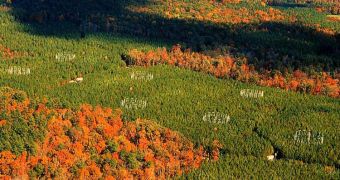According to the conclusions of a new scientific investigation carried out by biology experts at the Indiana University, it would appear that mounting concentrations of atmospheric carbon dioxide (CO2) is causing the global carbon cycle to accelerate, and subsequently drives forest soil carbon loss.
The correlation is proportional, meaning that any further increase in atmospheric CO2 levels will lead to even more carbon loss from forest soils, where the chemical is sorely needed. The global carbon cycle is one of the most important natural cycles on Earth, experts say.
One of the most interesting emerging views in the international scientific community is that forests do not store most of the carbon they remove from the atmosphere inside dead organic matter in soils, but rather in its living woody biomass.
The lead author of the new research paper, IU College of Arts and Sciences assistant professor of biology Richard P. Phillips, has been studying forest ecosystems for nearly two decades, investigating how they respond to climate change, global warming, and mounting atmospheric CO2 concentrations.
“It's been suggested that as trees take up more carbon dioxide from the atmosphere, a greater amount of carbon will go to roots and fungi to acquire nutrients, but our results show that little of this carbon accumulates in soil because the decomposition of root and fungal detritus is also increased,” he says.
According to the expert, the new study was carried out in North Carolina, at the Duke Forest Free Air Carbon Dioxide Enrichment site, where mature loblolly pine trees were exposed to increased levels of carbon dioxide for around 14 years.
This makes the site of the longest-running carbon dioxide enrichment experiments ever conducted. Scientists are performing such studies in order to determine how future ecosystems will react when faced with massive CO2 surges.
Under elevated carbon conditions, the nitrogen cycle in the soils also got accelerated. Trees and microbes began extracting much more of the chemical from the ground, depleting available reserves.
“The growth of trees is limited by the availability of nitrogen at this site, so it makes sense that trees are using the 'extra' carbon taken up under elevated CO2 to prime microbes to release nitrogen bound up in organic matter,” Phillips explains.
“What is surprising is that the trees seem to be getting much of their nitrogen by decomposing root and fungal detritus that is less than a year old,” he concludes.

 14 DAY TRIAL //
14 DAY TRIAL //